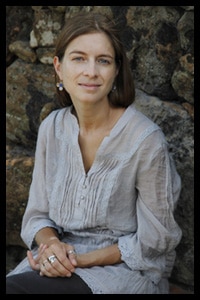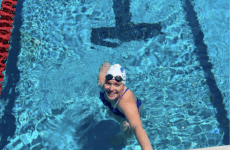By Kaitlyn Boisvert –
On March 26, Newport, R.I. was met with rather dreary weather, which forced many to take shelter underneath coats, umbrellas and warm scarves. It could have been described as a “miserable” day; one that reflected New England weather at its ugliest.
One of the people who braved the harsh environment was Anna Badkhen, a renowned journalist who came to Salve Regina University to share her journalism expertise and experience with the community. With an impressive resume that documents Badkhen’s coverage for war-stricken countries such as Afghanistan and Iraq, it was clear that trekking through Newport on a rainy day was hardly much of a challenge to the journalist.
In the opening of her presentation, Badkhen introduced herself, saying, “My name is Anna Badkhen, and I am a storyteller.”
Acknowledging that it may have seemed a bit peculiar that she was addressing herself as a storyteller, rather than as a journalist, Badkhen went on to explain how effective journalism required good storytelling, in order to make a true impact. In order to convey the importance of this theme, Badkhen recited a quote spoken by Barry Lopez, which stated: “Everything is held together with stories. That is all that is holding us together, stories and compassion.”
With these powerful words, Badkhen delved into the heart of her lecture, which was recounting her experience in traveling and bringing her journalistic curiosity to Afghanistan, in a time where most Americans only knew it as the country where American troops were being sent abroad to partake in a controversial war.
Through her reporting and observations, Badkhen aspired to provide people with a new glimpse of a country that mostly received only one form of coverage and perspective in the news. To accomplish this, Badkhen lived in an Afghan village, where she befriended the villagers, listened to their stories and learned their ways of living. She recounted her experiences in a book titled Peace Meals: Candy-Wrapped Kalashnikovs and Other War Stories, and shared a bit of her memories with her audience present.
She bonded with an Afghan family, who invited her to their gatherings and taught her their traditional customs. She became such a regular that she was soon considered to be a part of the family. The mother lovingly referred to her as “Anna the crazy, my daughter.” She would help the family in spreading out the tablecloth at dinner and revealed that the mother has now set aside her plates for the day Anna will one day return.
During her stay, Badkhen also tried camel yogurt, a delicacy with a taste she described as “liquid moonlight.” While it may seem strange for a traveling journalist to focus their attention on a seemingly menial detail, Badkhen explained that food is actually a very important element in storytelling. “Food is something relatable,” said Badkhen. “It is something that people know, and it is something that often brings people together and it is for that reason it can really help in setting a scene.”
In describing the food present during her stay, Badkhen wished to successfully convey the main objective of both her reporting and her presentation – to remind her audience that the Afghan people they see on the news are also human, who partake in a lot of daily activities similar to their own. They dance for fun, they listen to upbeat pop songs, and they share love through cooking and socializing at the dinner table. They also experience happiness, heartbreak, anger and sorrow, just like everyone else.
It is through observing these villagers in such simple, yet pivotal moments that people can finally see these Afghans as humans with stories, rather than anonymous casualties with blurred faces and identities in a brief news coverage highlighting the casualties of war.
Badkhen then proceeded to delve into one of her biggest responsibilities as a traveling journalist – to reveal the truths of her assigned destination and bring to light what needed to be recognized. She reminded the audience how things are less than perfect in Afghanistan, since the residents live in a war zone where danger lurks like an overcast shadow.
She recounted the high number of casualty deaths in the country and revealed that during her stay, she slept in a straw hut crowded with other resting women because in a time of danger and turmoil, closeness seemed to be capable of “staving off war”. She also recalled how she could often hear military airplanes cruising overhead, shaking the ground with their impending presence. She began to fear for the life of the young girl she had befriended because a girl her same age had accidentally been killed in a raid, only a few blocks away.
Badkhen’s vivid description of living in danger successfully conveyed the sense of turmoil that has plagued the country of Afghanistan for many years. Through providing a perspective that shares their viewpoint, Badkhen hoped she could encourage her audiences to open their eyes and attempt to see Afghans on the same level.
“When we see Afghanistan on the news, we almost pass it off, thinking that because it is so far away, it has nothing to do with us,” she said, “but that is not true – we also play an important role and we should take it upon ourselves to not just express sympathy, but also empathy- to at least attempt to understand what they are going through.”
While some journalists criticize the modern day audience, claiming that they have short attention span for peace and generally do not care for things that do not concern them, Badkhen objected this notion. “We journalists are lazy and a bit disrespectful to our audience when we say they have a short attention span,” she said. “Because it is not true, we create people’s attention spans and we can teach them to be compassionate. The audience is capable of feeling empathy – it is just like a muscle, which needs to be flexed in order to truly become effective.”
With her message for compassion, awareness and empathy, Badkhen truly embodied the theme of how journalism can make a positive impact.















